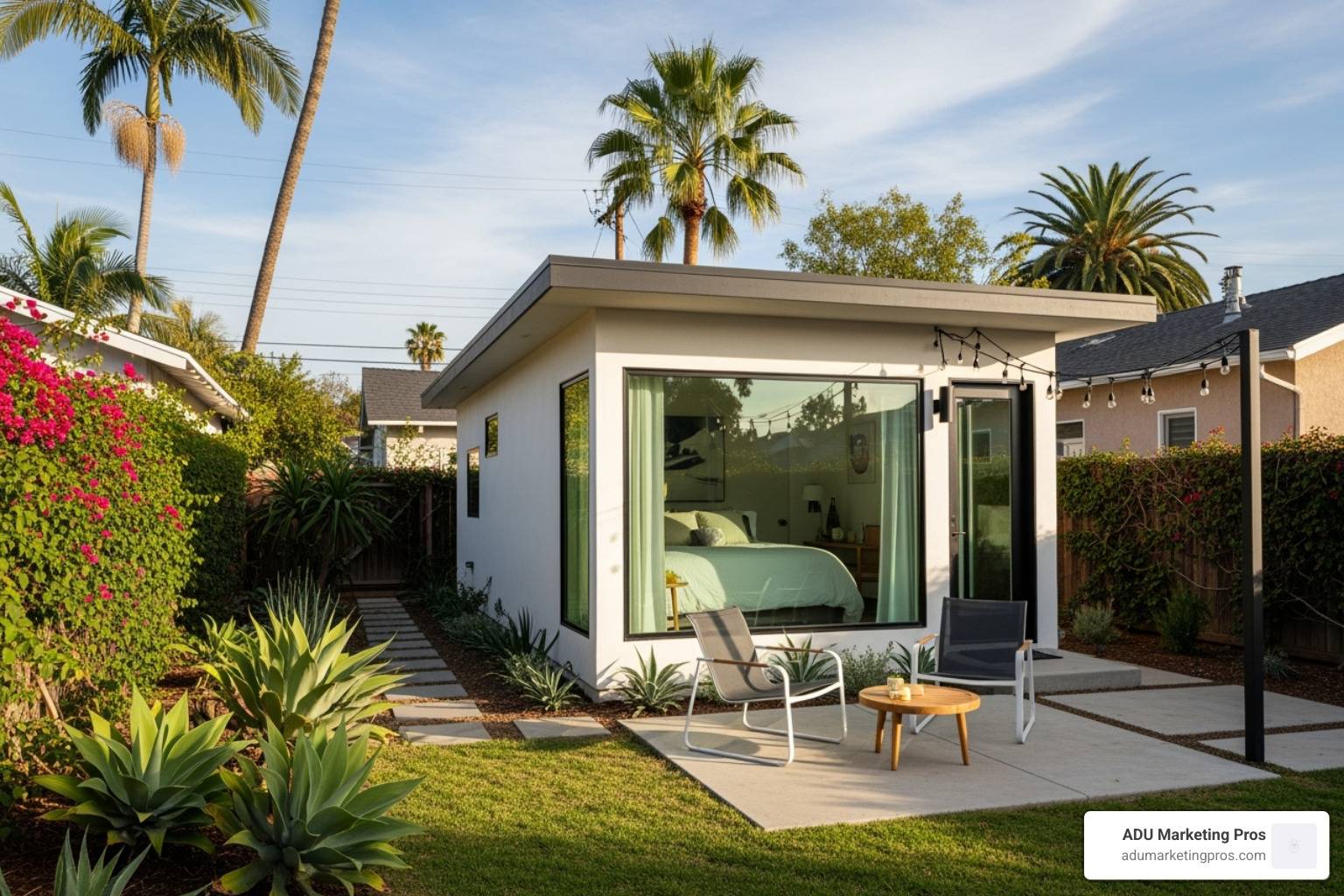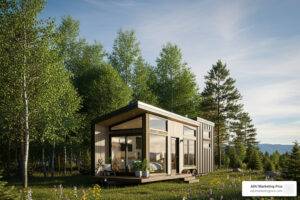Why ADU Floor Plans Are Essential for Los Angeles Homeowners
In the dynamic and changing landscape of Los Angeles real estate, the Accessory Dwelling Unit (ADU) has emerged as a powerful tool for homeowners. Driven by a critical housing shortage and progressive state legislation, ADUs are changing single-family lots into more flexible, valuable, and functional properties. At the heart of this change lies the single most important decision a homeowner will make: the floor plan. The choice of adu floor plans los angeles residents select dictates not just the layout of a new structure, but its ultimate purpose, financial return, and daily livability.
ADU floor plans in Los Angeles generally fall into four main categories: compact studios (200-400 sq ft), versatile one-bedrooms (400-750 sq ft), family-friendly two-bedrooms (750-1,000 sq ft), and expansive three-bedrooms (up to the 1,200 sq ft maximum). To simplify and expedite the building process, the Los Angeles Department of Building and Safety (LADBS) has created a Standard Plan Program, offering pre-approved designs across these sizes.
Quick ADU Floor Plan Options:
- Studio ADUs: 200-400 sq ft, perfect for dedicated home offices, guest suites, or single-person rentals.
- One-Bedroom ADUs: 400-750 sq ft, the ideal choice for long-term rentals, in-law suites, or couples.
- Two-Bedroom ADUs: 750-1,000 sq ft, great for small families, roommate arrangements, or generating higher rental income.
- Three-Bedroom ADUs: Up to 1,200 sq ft, providing maximum space for multi-generational living or as a primary residence.
The surge in ADU construction across Los Angeles is a direct response to relaxed permitting laws and immense housing demand. With dozens of pre-approved plans and endless custom possibilities, homeowners have an unprecedented opportunity to add significant living space and value to their properties. The right floor plan is a strategic decision that hinges on your specific goals—whether you aim to generate rental income, provide housing for family members, or create the ultimate home office. A crucial financial consideration is that ADUs under 750 sq ft are exempt from impact fees in California, making this size a particularly cost-effective and popular choice. The sheer variety of designs ensures that nearly every Los Angeles property can find a suitable ADU solution to maximize its functionality, comfort, and overall property value.

Important adu floor plans los angeles terms:
The Blueprint for Your Backyard: Common ADU Types
Choosing the right type of ADU for your Los Angeles property is a foundational decision that impacts everything from budget and timeline to the final layout. The best adu floor plans los angeles options are intrinsically linked to the ADU type you select. Each approach, from a brand-new detached ADU to a clever garage conversion, offers a unique set of advantages and challenges that must be weighed against your property’s constraints and your personal goals.
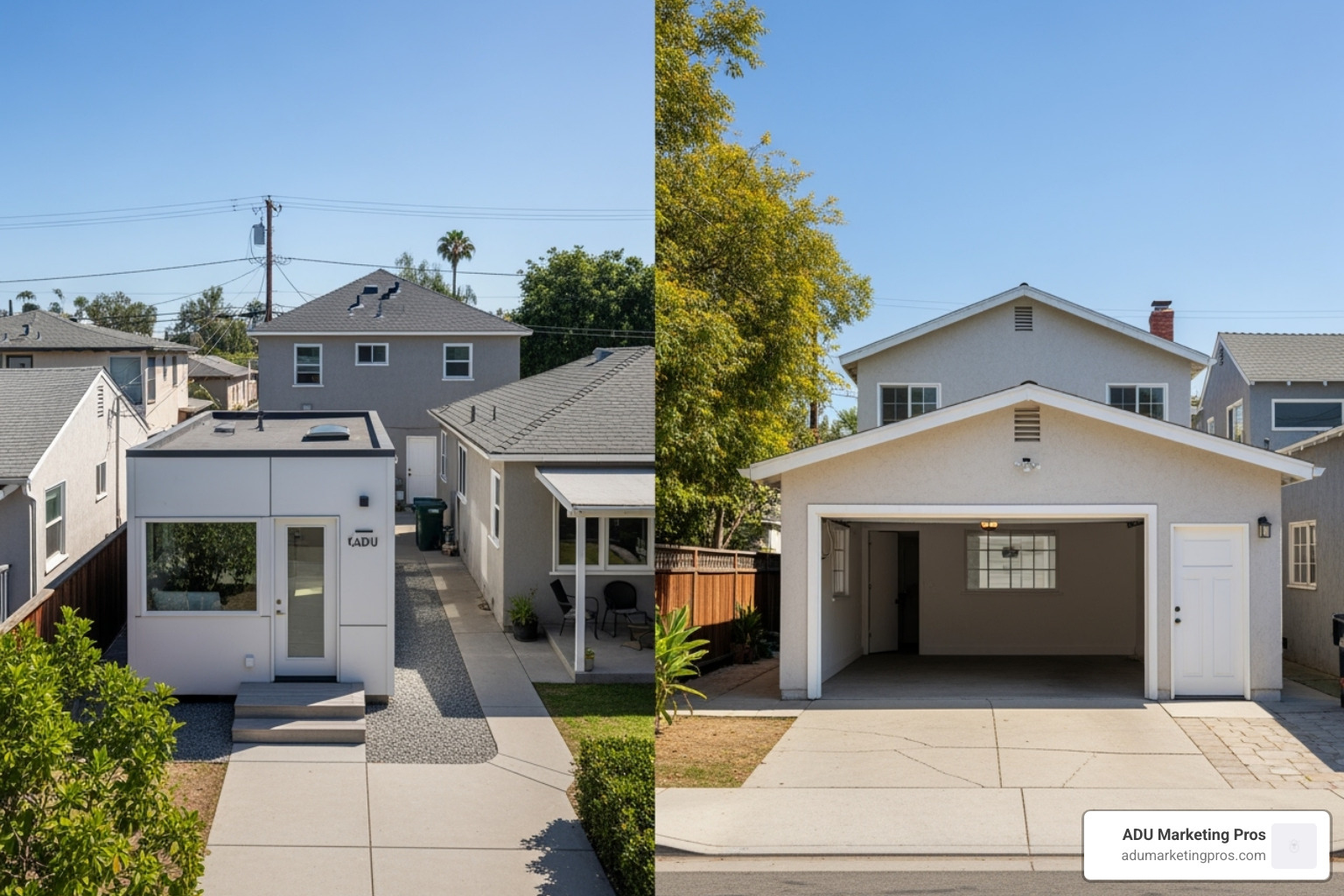
Understanding how different ADU types fit your property and needs is key. Common choices for Los Angeles homeowners include garage conversions, attached ADUs, Junior Accessory Dwelling Units (JADUs), and even two-story ADUs for maximizing space on smaller lots. For comprehensive guidance on what’s allowed, check out our detailed resource: More info about ADU guidelines in Los Angeles.
Detached New Construction
Building a standalone unit from the ground up offers the ultimate creative control and long-term value. This approach allows you to design every aspect of the ADU to perfectly match your needs, style, and the orientation of your lot. These units provide maximum privacy for both the occupants of the main home and the ADU residents, a key feature for rental units. With complete design freedom, you are not constrained by existing structures, allowing for optimal window placement, higher ceilings, and custom features. Detached ADUs often yield a higher potential ROI and are ideal for rentals, as they command premium rates by offering the feel of a small, private home. They can be built as single-story or two-story structures, depending on local height limits and your lot’s capacity.
Garage & Structure Conversions
Converting an existing garage or another underused structure is often the most cost-effective and fastest option for adding an ADU. The primary benefit is the significantly shorter construction timeline, as you are working with an existing foundation, walls, and roof. This not only saves a substantial amount of money on materials and labor but can also simplify the permitting process. These conversions are perfect for home offices, art studios, or rental units, and with thoughtful design, can be transformed into bright, modern, and highly functional living spaces. Garage conversions are incredibly versatile, allowing for anything from a simple studio to a one-bedroom or even a compact two-bedroom unit within the existing footprint, depending on the size of the original garage.
Attached ADUs
An attached ADU is a new unit that is built onto, and integrated with, the primary residence. It shares at least one wall with the main house but has its own separate entrance, kitchen, and bathroom facilities. This option is ideal for homeowners who want to keep family members close, such as aging parents or adult children, while still providing a degree of independence. Attached ADUs can be more cost-effective than detached new construction as they can sometimes tie into the main home’s existing plumbing and electrical systems. Careful planning of the floor plan is crucial to ensure soundproofing and privacy between the two living spaces.
Junior Accessory Dwelling Units (JADUs)
A JADU is a specialized type of ADU with its own set of rules. Limited to 500 square feet, a JADU must be created within the existing, habitable footprint of the primary home, often by converting a spare bedroom or an attached garage. They require an efficiency kitchen (with smaller appliances and limited counter space) and a separate exterior entrance. A JADU can share a bathroom with the main house, which can reduce construction costs. A key regulation is that the owner must reside in either the main house or the JADU. This makes them an excellent, low-cost option for housing a single family member, a student, or a caregiver.
Popular ADU Layouts by Size
Understanding popular ADU layout categories can simplify choosing the right size for your adu floor plans los angeles project. California state law permits ADUs of up to 1,200 square feet, and within this range, four main size categories have become the most popular choices for LA homeowners. Each category offers distinct advantages custom to different needs, from generating rental income to facilitating multi-generational living. With intelligent design, even a 300-square-foot studio can feel open and spacious, while a 1,200-square-foot unit can function as a complete, luxurious secondary home.
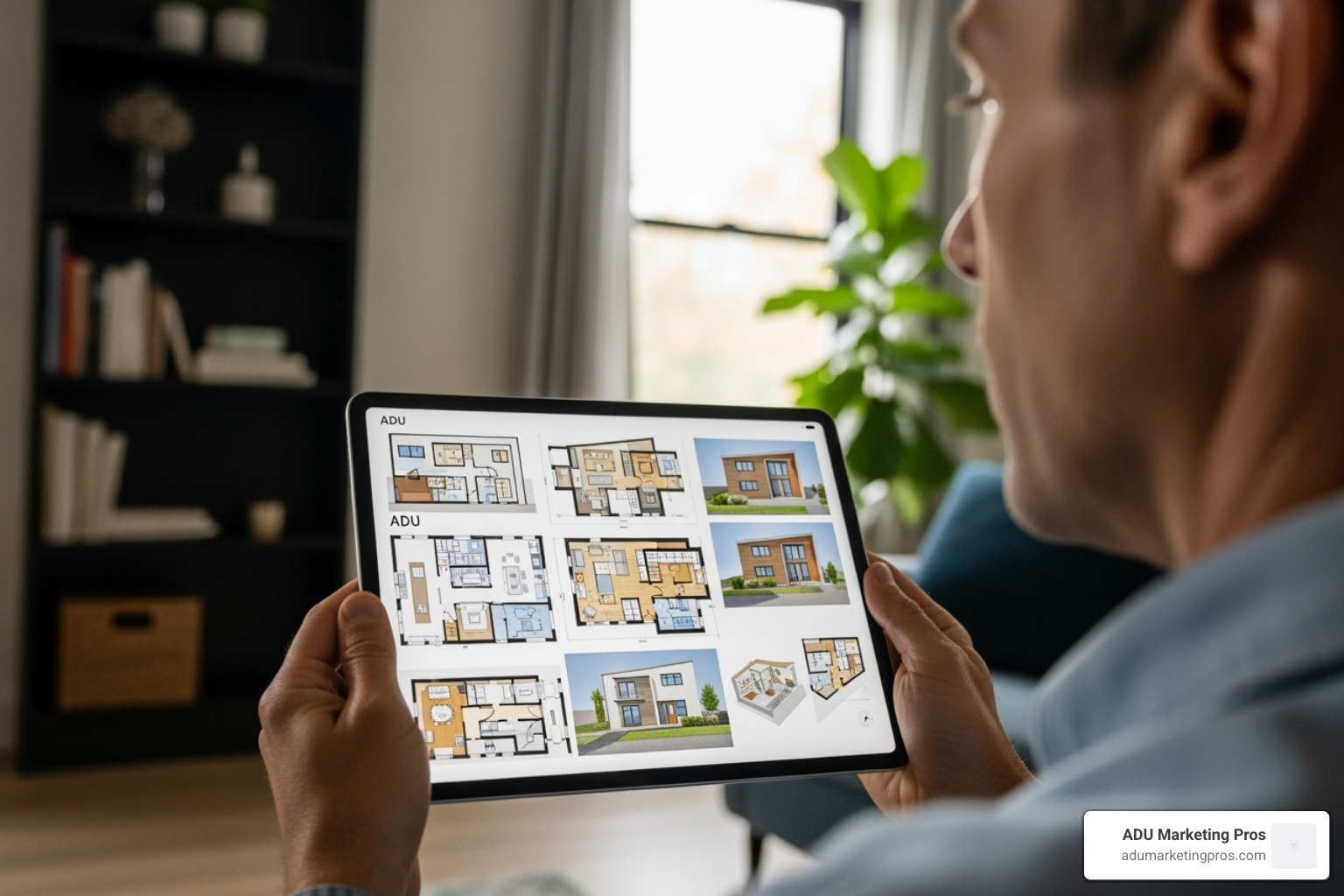
The Compact Studio (Under 400 sq ft)
Studio ADUs, typically ranging from 200 to 350 square feet, are masters of efficiency, combining living, sleeping, and kitchen functions into a single, open area. The key to a successful studio floor plan is maximizing every square inch. Common layouts include a linear kitchen along one wall to open up the main living space. Smart design features like high ceilings, clerestory windows, skylights, and large glass doors can make these compact units feel surprisingly spacious and filled with natural light.

They are ideal as private guest suites, dedicated home offices, or affordable rentals for single occupants like students or young professionals. The open-concept design demands clever furniture choices, such as Murphy beds that fold away, convertible sofas, drop-leaf dining tables, and extensive built-in storage. A well-designed studio proves that a small footprint doesn’t have to mean sacrificing comfort or style; it can be a complete and comfortable home.
The Versatile One-Bedroom (400-750 sq ft)
Ranging from 400 to 750 square feet, one-bedroom ADUs represent a significant step up in functionality, offering distinct living and sleeping areas that make the unit feel like a true home. A typical floor plan includes a full kitchen, a comfortable living area, a separate bedroom with a closet, and a full bathroom. This separation provides crucial privacy and acoustic separation, making them highly desirable for tenants and family members alike.
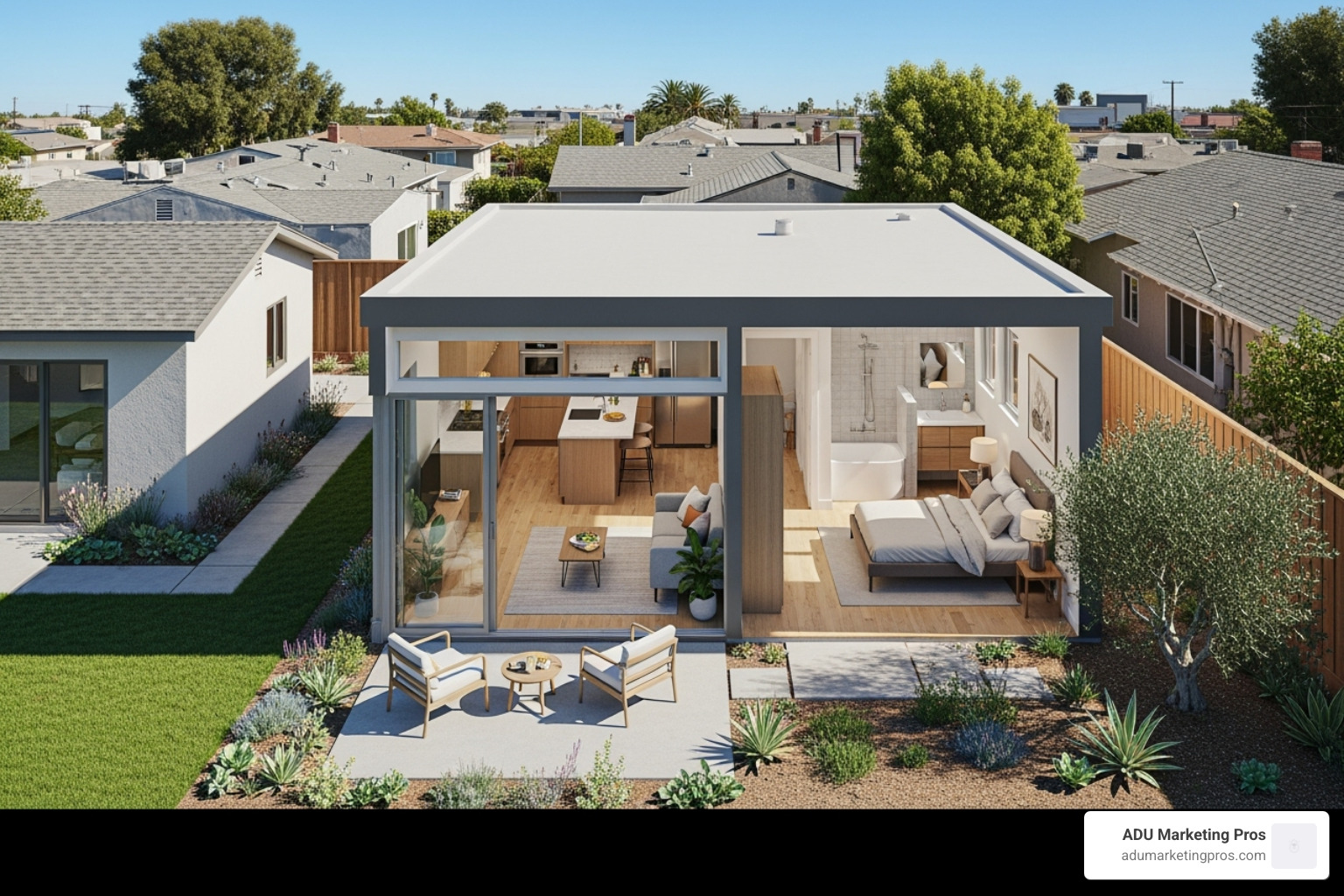
A major financial advantage is that ADUs under 750 square feet are exempt from California’s development and impact fees, which can save homeowners thousands of dollars. This makes the 749-square-foot one-bedroom ADU one of the most popular and cost-effective choices in Los Angeles. These units are excellent for long-term rentals for individuals or couples, or as comfortable in-law suites. With clever design, a 750-square-foot footprint can sometimes even accommodate two small bedrooms, further increasing its utility and rental potential. For design guidance, explore our ADU Building Plans resource.
The Family-Friendly Two-Bedroom (750-1,000 sq ft)
Two-bedroom ADUs, typically between 750 and 1,000 square feet, are ideal for small families, roommates, or homeowners looking to maximize their rental income. These units provide the necessary privacy and function for a larger household, usually featuring a full kitchen, a spacious living area, two distinct bedrooms, and one or two bathrooms. An en-suite bathroom for the primary bedroom is a highly sought-after feature in these layouts.
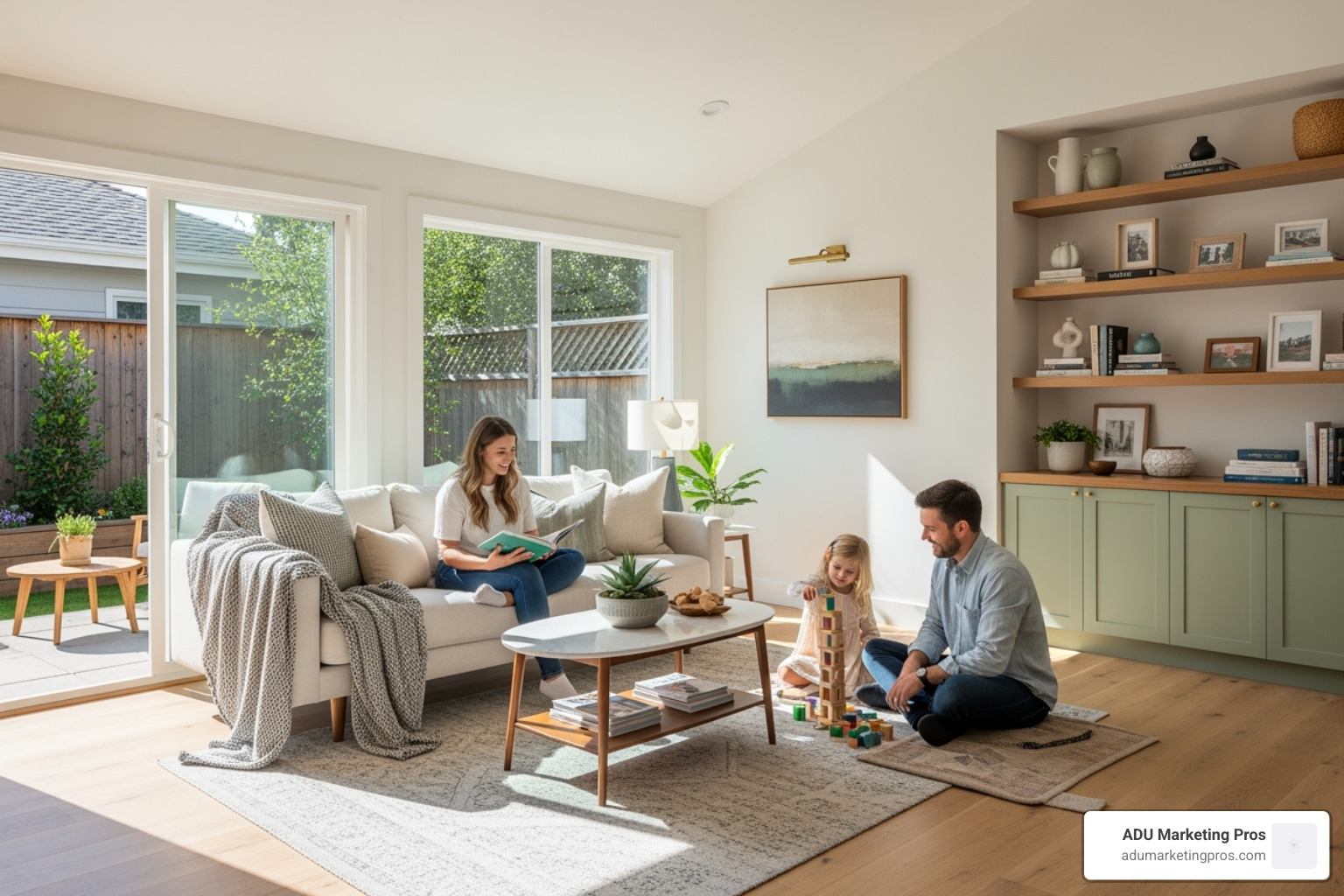
From a financial perspective, two-bedroom units command significantly higher rental rates and appeal to a broader range of tenants. The floor plan is flexible; the second bedroom can easily serve as a home office, a nursery, or a guest room. Optimizing the layout is key to success. Good designs separate the bedrooms for privacy, create an open-concept kitchen and living area to maximize the sense of space, and incorporate ample storage solutions like closets and pantries.
The Expansive Three-Bedroom (Up to 1,200 sq ft)
At the maximum allowable size of 1,200 square feet, a three-bedroom ADU offers the ultimate in secondary living. These units function as complete, comfortable homes, often featuring multiple bathrooms, large open-concept kitchens with islands, dedicated laundry rooms, and generous storage. The floor plan possibilities are vast, allowing for luxury features and a high degree of customization.
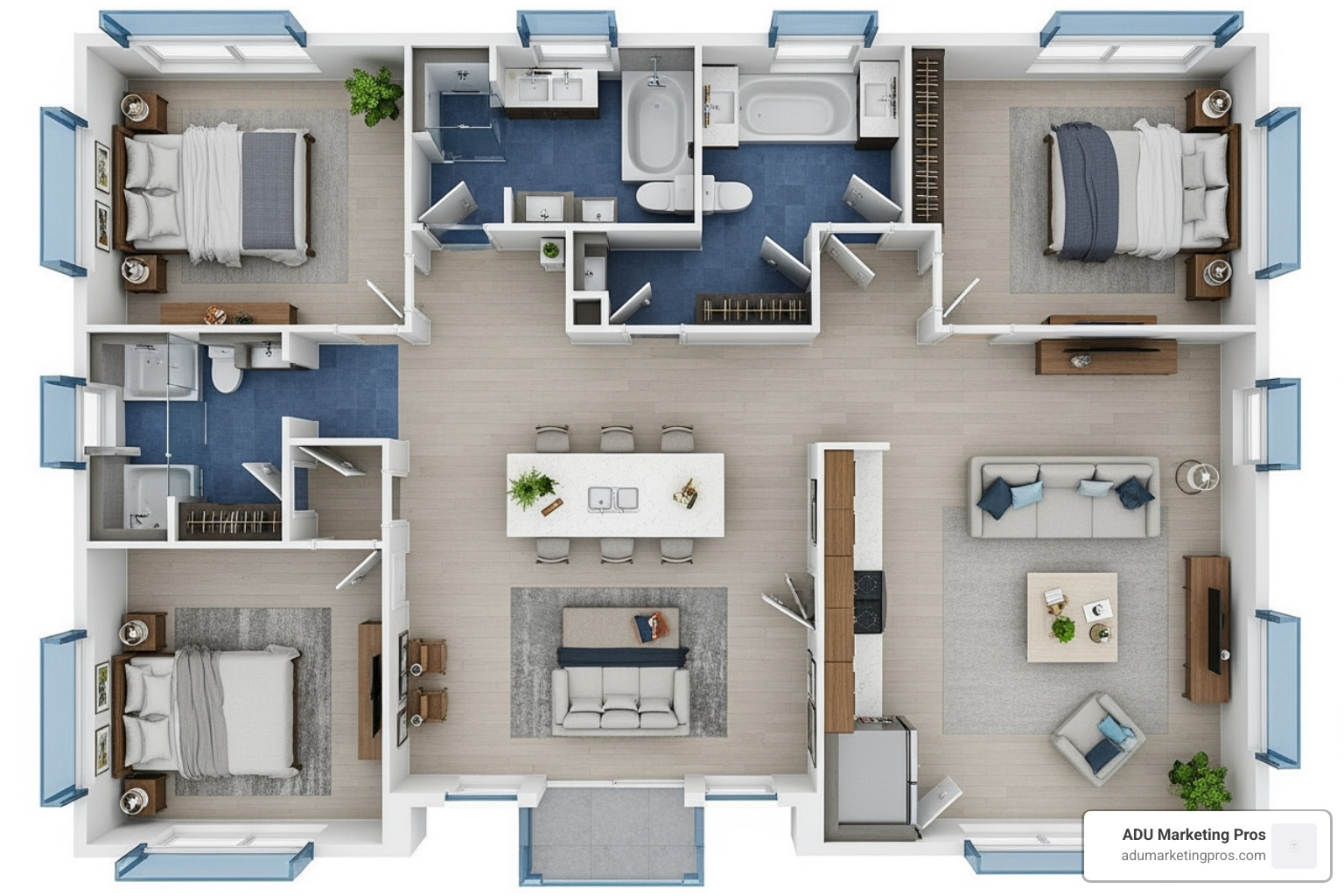
This size is perfect for comfortable multi-generational living, allowing for layouts where aging parents can have a ground-floor master suite while other family members occupy the additional rooms. From an investment standpoint, three-bedroom ADUs yield the highest potential rental income, attracting families who need the space of a full home. These expansive units can also serve as a luxury guest house or even as the homeowner’s primary residence while the main house is rented out for maximum income (a strategy known as “house hacking”). Explore high-end design ideas in our collection of Modern ADU Floor Plans.
Navigating the Rules: LA’s ADU Regulations and Permitting
Successfully building an ADU in Los Angeles requires a clear understanding of both state and local regulations. While California state laws have dramatically simplified the process and removed many historical barriers, homeowners must still steer the specific requirements of the Los Angeles Department of Building and Safety (LADBS) and other local agencies. A well-designed floor plan is useless if it doesn’t comply with these crucial rules.
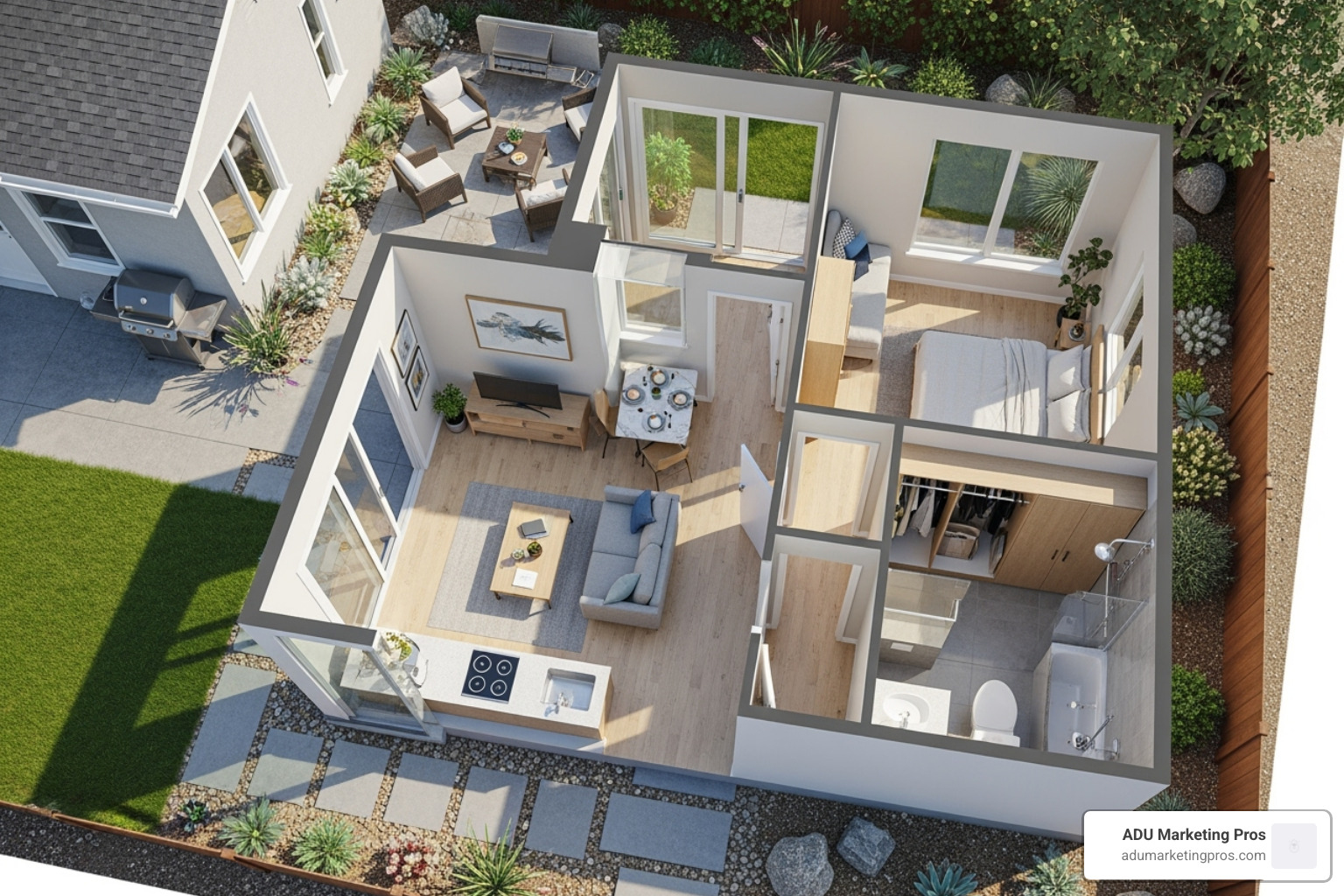
The LADBS has made significant efforts to streamline ADU permitting, most notably through its Standard Plan Program. However, every project, whether using a pre-approved or custom plan, must undergo a thorough review process. A complete and accurate application package is critical to avoiding costly delays.
Key Regulations for Los Angeles ADUs:
- Setbacks: State law mandates a minimum of 4-foot side and rear yard setbacks for new detached ADUs. This is a major advantage for homeowners with smaller LA lots, allowing them to build where it was previously impossible. No setbacks are required for existing, legally permitted structures that are converted to an ADU.
- Height Limits: For a detached ADU, the height limit is typically 16 feet for a single-story unit. A two-story ADU may be permitted up to 25 feet, but this can be subject to more restrictive local zoning overlays. Attached ADUs cannot be taller than the primary residence.
- Lot Coverage & Size: An ADU of at least 800 sq ft must be permitted regardless of local lot coverage limitations. The maximum size is 1,200 sq ft for a detached ADU, while an attached ADU cannot exceed 50% of the main house’s square footage.
- Parking Exemptions: This is a significant benefit for adu floor plans los angeles homeowners. No additional parking is required for an ADU if the property is located within a half-mile walking distance of public transit, or if the ADU is part of a garage conversion. Most properties in Los Angeles qualify for this exemption.
- Fire Safety: Properties located in a Very High Fire Hazard Severity Zone (VHFHSZ) are subject to stricter building codes. This requires the use of fire-resistant materials for roofing (Class A), exterior walls (non-combustible siding), and windows (dual-paned with at least one pane of tempered glass).
- Green Building & Energy Codes: All new ADUs must comply with the California Green Building Standards Code (CALGreen). This includes meeting Title 24 energy efficiency requirements for insulation, cool roofs, and high-efficiency windows and HVAC systems. As of 2023, most new ADUs also require the installation of a solar photovoltaic (PV) system.
- School Impact Fees: For ADUs of 500 square feet or more, the Los Angeles Unified School District (LAUSD) levies a school impact fee. These fees are subject to change and add to the overall project cost. You can find details in the LAUSD School Fee Justification Study.
The permitting process itself involves a plan check review by multiple city departments, including Building & Safety, City Planning, and sometimes Public Works. Once plans are approved and a permit is issued, construction can begin, but it will be punctuated by a series of mandatory inspections (e.g., foundation, framing, electrical, plumbing, and final). Understanding these rules from the outset is essential for a smooth and predictable project. For more details, see our guide: More on Los Angeles ADU Regulations.
Fast-Track Your Project with Pre-Approved ADU Floor Plans in Los Angeles
For homeowners looking to simplify and accelerate their ADU project, the LADBS Standard Plan Program is an invaluable resource. This program offers a portfolio of pre-approved ADU floor plans designed by licensed architects and engineers, which can significantly streamline the often-daunting permitting process, making it faster and more cost-effective to build in Los Angeles.
How the LADBS Standard Plan Program Works:
- City-Vetted Designs: These plans have already been reviewed by LADBS for compliance with building, residential, and green codes. This pre-approval completes a major portion of the plan check process before you even submit your application.
- Faster Permit Issuance: Because the core design is already approved, the city’s review is focused on site-specific elements. This can reduce permit wait times from many months to as little as 30-60 days in some cases.
- Cost Savings: While some plans require a purchase fee from the design firm, the savings in architectural fees and reduced plan check hours can be substantial, lowering overall project soft costs.
- Variety of Options: The program features a growing catalog of plans, from compact 200 sq ft studios to large 1,200 sq ft three-bedroom units, with various architectural styles and both 1-story and 2-story options.
Pros and Cons of Using Pre-Approved Plans
Pros:
- Speed: The single biggest advantage is the drastically reduced permitting timeline.
- Cost-Effectiveness: Lower architectural and plan check fees can save thousands of dollars.
- Certainty: You are starting with a design that is already proven to be code-compliant, reducing the risk of major redesigns.
Cons:
- Limited Customization: The floor plan and elevations are fixed. You cannot make significant changes to the layout.
- Site-Specific Challenges: A pre-approved plan may not be perfectly oriented for your lot’s solar access, views, or utility connection points.
- Site Plan Still Required: You must still hire a professional to create a site-specific plan showing the ADU’s location on your property, foundation design, and utility connections. This still requires an investment of time and money.
Even with a standard plan, LADBS conducts a site-specific review for zoning compliance, foundation engineering, and utility hookups to ensure the plan is appropriate for your specific property. This program is an excellent resource for homeowners whose needs align with one of the available designs. You can browse the full catalog on the official city website: LADBS Approved Standard Plans. For more details, see our guide: More on Pre-Approved ADU Plans in Los Angeles.
Frequently Asked Questions about ADU Floor Plans in Los Angeles
Building an ADU in Los Angeles is an exciting prospect, but it naturally brings up many questions for homeowners. Here are detailed answers to some of the most common inquiries regarding adu floor plans los angeles projects.
What is the maximum size for an ADU in Los Angeles?
In Los Angeles, the maximum allowable size for a new detached ADU is 1,200 square feet, in line with California state law. However, the specific size you can build depends on the type of ADU and your property’s characteristics:
- Detached ADUs: Can be built up to 1,200 sq ft, provided they contain no more than two bedrooms. For ADUs with three or more bedrooms, the size limit may be larger if local zoning allows.
- Attached ADUs: These are limited to 50% of the primary dwelling’s living area. For example, on a property with a 2,000 sq ft main house, the attached ADU cannot exceed 1,000 sq ft.
- Junior Accessory Dwelling Units (JADUs): Are strictly capped at 500 square feet and must be created within the existing footprint of the main home.
- The 750 sq ft Sweet Spot: Many homeowners strategically design their ADUs to be just under 750 square feet. This is because ADUs of this size are exempt from most local agency impact fees (like park and recreation fees), which can result in significant cost savings.
Can I design my own ADU floor plans for Los Angeles?
While your personal vision, sketches, and ideas are the crucial starting point, the official adu floor plans los angeles requires for a permit application must be prepared, signed, and stamped by a California-licensed architect or engineer. This is a non-negotiable requirement to ensure the plans comply with the extensive California Building Code, which includes complex standards for structural integrity (seismic safety), energy efficiency (Title 24), fire safety, and accessibility.
You should collaborate closely with your chosen professional, sharing your needs, desired layout, and budget. They will translate your concepts into a full set of code-compliant construction documents ready for city submission. To save time and money, you can also consider purchasing “permit-ready” or “stock” plans from design firms, which can then be adapted to your site by a professional. For preliminary brainstorming, ADU Design Software can help you visualize layouts before engaging an architect.
How much do ADU floor plans cost in Los Angeles?
The cost for developing adu floor plans los angeles can vary widely based on the level of customization and service:
- Free Plans: The LADBS Standard Plan Program offers some basic designs for free, though they still require a site plan and engineering.
- Privately-Owned Pre-Approved Plans: These typically cost between $750 to $2,000 for the license to use the plan set.
- Stock or Semi-Custom Plans: These plans, which offer some customization, often range from $5,000 to $10,000. This may include the architectural and structural plans needed for permitting.
- Fully Custom Designs: For a unique design custom perfectly to your property and needs, expect to pay $15,000 to $30,000+ for a full architectural service package. This typically includes design development, construction documents, and assistance with the permit process.
These costs are for the plans themselves. You will also need to budget for city permit fees, plan check fees, school impact fees (for ADUs 500 sq ft or larger), and potentially utility connection fees. For a full cost breakdown, see our guide: More on Los Angeles ADU Cost.
How will an ADU affect my property taxes?
Building an ADU will trigger a reassessment of your property value for tax purposes, but it’s not as drastic as it sounds. The County Assessor will not reassess the value of your entire property. Instead, they will perform a “blended assessment.” This means your existing home and lot will continue to be assessed based on their original purchase price (under Proposition 13), while only the new value of the ADU itself will be added to your tax bill. For example, if your ADU adds $300,000 in value, your property taxes will increase by approximately 1-1.25% of that $300,000, not the total new value of your entire property.
What are the utility connection requirements?
State law allows for flexibility. You can choose to create separate utility meters (water, gas, electric) for the ADU or connect the ADU to the main house’s meters. Separate meters can be costly upfront but make it easier to bill tenants for their actual usage. Tying into the main house’s utilities is cheaper to install but requires you to work out a system for splitting the bills (e.g., a flat monthly fee or a submeter). Your architect and builder can help you weigh the pros and cons of each approach.
Conclusion: Bringing Your ADU Vision to Life
Building an ADU in Los Angeles is a strategic investment that opens up a world of possibilities. It can provide a steady stream of rental income, create a private and comfortable home for family, or offer a dedicated space for work and creativity. The incredible versatility of adu floor plans los angeles homeowners can choose from ensures there is a perfect solution for every property, budget, and goal—from a hyper-efficient studio to a spacious three-bedroom family home. The key to open uping this potential is matching your chosen floor plan directly to your primary objective.
A successful ADU project is built on a foundation of meticulous planning. This journey begins with understanding the different ADU types, selecting a floor plan that maximizes your lot’s potential, and thoroughly navigating LA’s complex web of regulations and permitting requirements. While the process can seem daunting, it is manageable with the right preparation. Professional design expertise from an experienced architect or designer is not just a recommendation; it is a crucial component for ensuring your project is code-compliant, functional, and beautiful, ultimately preventing costly mistakes and delays.
For architecture, design, and construction firms in Los Angeles, the sustained demand for ADUs represents a significant and lasting business opportunity. Homeowners are actively seeking qualified experts to guide them through the design, permitting, and construction process from start to finish.
At ADU Marketing Pros, we specialize in bridging the gap between these homeowners and the professionals who can bring their vision to life. We develop targeted marketing strategies that showcase your firm’s unique expertise, helping you attract high-quality leads and stand out in a competitive marketplace.
With thoughtful planning and expert professional guidance, any homeowner’s ADU vision can become a valuable, functional, and rewarding reality. If you are an ADU professional ready to grow your business, we can provide the marketing tools to connect you with clients who value quality, design, and expertise. Find out how to market your ADU architecture services and build your project pipeline.

